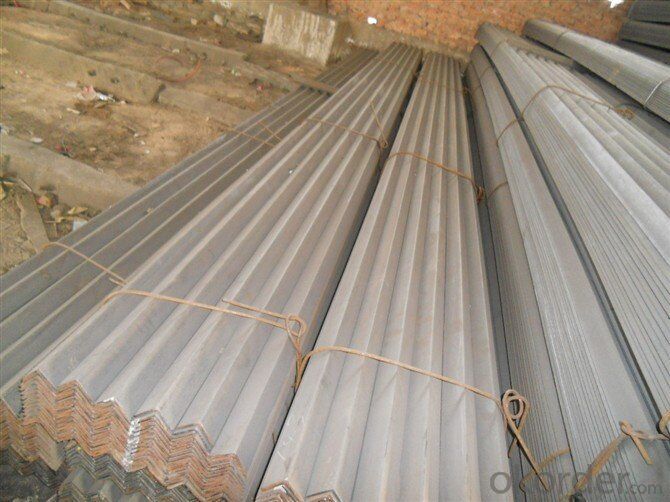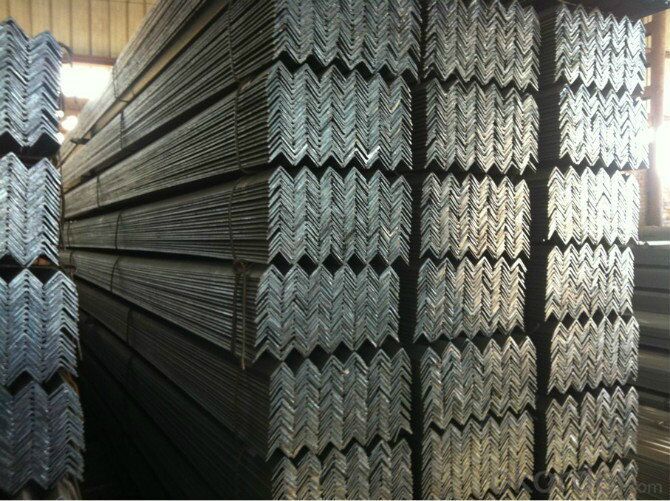2015 Hot Rolled Angle Steel in GB Standard
- Loading Port:
- Tianjin
- Payment Terms:
- TT OR LC
- Min Order Qty:
- 25 m.t.
- Supply Capability:
- 20000 m.t./month
OKorder Service Pledge
OKorder Financial Service
You Might Also Like
Item specifice
OKorder is offering high quality Hot Rolled Steel Angle at great prices with worldwide shipping. Our supplier is a world-class manufacturer of steel, with our products utilized the world over. OKorder annually supplies products to European, North American and Asian markets. We provide quotations within 24 hours of receiving an inquiry and guarantee competitive prices.
Product Applications:
Hot Rolled Steel Angles are ideal for structural applications and are widely used in the construction of buildings and bridges, and the manufacturing, petrochemical, and transportation industries.
Product Advantages:
OKorder's Steel Angles are durable, strong, and resist corrosion.
Main Product Features:
· Premium quality
· Prompt delivery & seaworthy packing (30 days after receiving deposit)
· Corrosion resistance
· Can be recycled and reused
· Mill test certification
· Professional Service
· Competitive pricing
Product Specifications:
Manufacture: Hot rolled
Grade: Q195 – 235
Certificates: ISO, SGS, BV, CIQ
Length: 6m – 12m, as per customer request
Packaging: Export packing, nude packing, bundled
Sizes: 25mm-250mm | ||
a*t | ||
25*2.5-4.0 | 70*6.0-9.0 | 130*9.0-15 |
30*2.5-6.6 | 75*6.0-9.0 | 140*10-14 |
36*3.0-5.0 | 80*5.0-10 | 150*10-20 |
38*2.3-6.0 | 90*7.0-10 | 160*10-16 |
40*3.0-5.0 | 100*6.0-12 | 175*12-15 |
45*4.0-6.0 | 110*8.0-10 | 180*12-18 |
50*4.0-6.0 | 120*6.0-15 | 200*14-25 |
60*4.0-8.0 | 125*8.0-14 | 250*25 |
FAQ:
Q1: Why buy Materials & Equipment from OKorder.com?
A1: All products offered byOKorder.com are carefully selected from China's most reliable manufacturing enterprises. Through its ISO certifications, OKorder.com adheres to the highest standards and a commitment to supply chain safety and customer satisfaction.
Q2: How do we guarantee the quality of our products?
A2: We have established an advanced quality management system which conducts strict quality tests at every step, from raw materials to the final product. At the same time, we provide extensive follow-up service assurances as required.
Q3: How soon can we receive the product after purchase?
A3: Within three days of placing an order, we will begin production. The specific shipping date is dependent upon international and government factors, but is typically 7 to 10 workdays.
Alloy No | Grade | Element (%) | |||||
C | Mn | S | P | Si | |||
Q235 | B | 0.12—0.20 | 0.3—0.7 | ≤0.045 | ≤0.045 | ≤0.3 | |
Alloy No | Grade | Yielding strength point( Mpa) | |||||
Thickness (mm) | |||||||
≤16 | >16--40 | >40--60 | >60--100 | ||||
≥ | |||||||
Q235 | B | 235 | 225 | 215 | 205 | ||
Alloy No | Grade | Tensile strength (Mpa) | Elongation after fracture (%) | ||||
Thickness (mm) | |||||||
≤16 | >16--40 | >40--60 | >60--100 | ||||
≥ | |||||||
Q235 | B | 375--500 | 26 | 25 | 24 | 23 | |
Images:


- Q:Can steel angles be used for reinforcing steel structures?
- Yes, steel angles can be used for reinforcing steel structures. Steel angles are versatile and widely used in construction projects for their strength and durability. They can be used as reinforcements to strengthen and provide additional support to steel structures such as beams, columns, and trusses. Steel angles are often used in conjunction with other reinforcing materials, such as steel bars or mesh, to enhance the overall structural integrity of the steel structure. The angle shape of the steel angles allows them to be easily welded or bolted into place, making them a popular choice for reinforcing steel structures. Additionally, steel angles come in various sizes and thicknesses, allowing for flexibility in design and application. Overall, steel angles are an effective and commonly used option for reinforcing steel structures.
- Q:What is the cost of a steel angle?
- The price of a steel angle may differ based on various factors including its size, grade, thickness, and the supplier or manufacturer chosen. Typically, steel angles are priced either per length or per weight. When determining the cost, it is crucial to take into account the market situation, location, and specific requirements of the desired steel angle. To obtain precise and current pricing details, it is advisable to reach out to local suppliers or manufacturers.
- Q:Can steel angles be used for support frames in industrial machinery?
- Yes, steel angles can be used for support frames in industrial machinery. Steel angles are commonly used in construction and fabrication due to their strength, durability, and versatility. They provide structural stability and support to various structures, including machinery frames. Steel angles are available in different sizes and thicknesses, allowing for customization to meet specific load-bearing requirements. Additionally, the inherent rigidity and high tensile strength of steel make it an ideal material for supporting heavy machinery and equipment in industrial settings.
- Q:Are there any limitations or restrictions on the use of steel angles in certain applications?
- Yes, there are limitations and restrictions on the use of steel angles in certain applications. These restrictions mainly depend on the specific engineering requirements, load bearing capacity, and structural stability needed for the application. Additionally, factors such as the type of project, environmental conditions, and building codes and regulations may also impose limitations on the use of steel angles. It is important to consult with a structural engineer or an industry professional to ensure proper selection and usage of steel angles for specific applications.
- Q:What is the typical yield stress of steel angles?
- The yield stress of steel angles can differ based on the grade and type of steel utilized. Nevertheless, for frequently employed carbon steels, the yield stress typically varies between 36,000 and 50,000 psi. This indicates that the steel angles can endure a specific level of stress or pressure prior to experiencing deformation or permanent alteration in shape. It is crucial to acknowledge that distinct steel alloys and treatments can lead to different yield stresses. Therefore, it is essential to refer to the specific specifications or reference materials pertaining to the particular steel angle in question.
- Q:What are the different load-carrying capacities for steel angles?
- The load-carrying capacities for steel angles can vary depending on several factors such as the size and shape of the angle, the type of steel used, and the specific application or use case. Generally, load-carrying capacities for steel angles are determined by considering the maximum allowable stress or load that the angle can withstand without experiencing permanent deformation or failure. This is often expressed in terms of the maximum axial or bending load that an angle can support. To determine the load-carrying capacity of a specific steel angle, engineers and structural designers refer to industry standards and guidelines, such as the American Institute of Steel Construction (AISC) Manual of Steel Construction. These standards provide tables and formulas that take into account various factors such as the angle's dimensions, thickness, and moment of inertia to calculate its load-carrying capacity. It is important to note that load-carrying capacities for steel angles are typically specified for specific loading conditions and safety factors. These factors include the type of load (e.g., axial or bending), the direction and magnitude of the applied load, and the safety factor required to ensure the structural integrity and durability of the angle. Therefore, it is essential to consult the relevant codes, standards, and engineering resources to determine the specific load-carrying capacity of a particular steel angle for a given application. Professional structural engineers and designers are best equipped to assess and determine the load-carrying capacities of steel angles based on their expertise and familiarity with the applicable design codes and standards.
- Q:What are the different types of connections for steel angles?
- There are several different types of connections for steel angles, including bolted connections, welded connections, and clip connections. Bolted connections involve using bolts and nuts to secure the angles together, while welded connections are created by melting the edges of the angles together. Clip connections use specially designed clips to hold the angles in place without the need for welding or bolting. Each type of connection has its own advantages and disadvantages, and the choice of connection method depends on factors such as the load-bearing requirements, ease of installation, and cost.
- Q:Are steel angles heat-treated?
- Yes, steel angles can be heat-treated. Heat treatment is a process in which the steel is subjected to controlled heating and cooling to alter its physical and mechanical properties. This can be done to achieve desired characteristics such as increased strength, hardness, toughness, or improved machinability. Heat treatment of steel angles is commonly carried out using methods such as annealing, quenching, tempering, or normalizing. The specific heat treatment process employed depends on the desired final properties and the intended application of the steel angles.
- Q:Can steel angles be used as structural supports?
- Indeed, structural supports can be provided by steel angles. Construction and engineering projects frequently employ steel angles due to their remarkable strength and stability. Their distinctive L-shape design renders them perfectly suited for lending support and ensuring structural integrity to various structures. Buildings, bridges, and other infrastructure projects often incorporate steel angles as beams, braces, or supports. These angles are capable of bearing heavy loads and resisting bending and compression forces, thereby establishing themselves as a dependable choice for structural support. Moreover, the ease of fabrication and installation associated with steel angles renders them a cost-effective solution for construction purposes.
- Q:How do you connect steel angles together?
- Steel angles can be connected together by various methods such as welding, bolting, or using steel angle brackets.
1. Manufacturer Overview |
|
|---|---|
| Location | |
| Year Established | |
| Annual Output Value | |
| Main Markets | |
| Company Certifications | |
2. Manufacturer Certificates |
|
|---|---|
| a) Certification Name | |
| Range | |
| Reference | |
| Validity Period | |
3. Manufacturer Capability |
|
|---|---|
| a)Trade Capacity | |
| Nearest Port | |
| Export Percentage | |
| No.of Employees in Trade Department | |
| Language Spoken: | |
| b)Factory Information | |
| Factory Size: | |
| No. of Production Lines | |
| Contract Manufacturing | |
| Product Price Range | |
Send your message to us
2015 Hot Rolled Angle Steel in GB Standard
- Loading Port:
- Tianjin
- Payment Terms:
- TT OR LC
- Min Order Qty:
- 25 m.t.
- Supply Capability:
- 20000 m.t./month
OKorder Service Pledge
OKorder Financial Service
Similar products
New products
Hot products
Related keywords




























